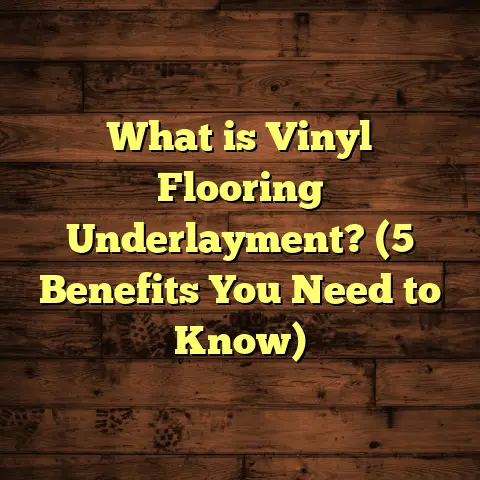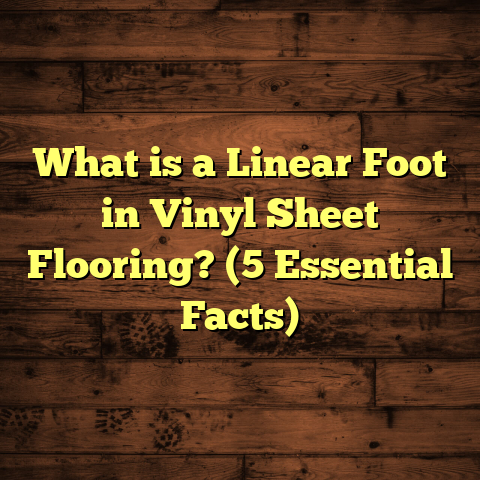What is Plywood Sturd I Floor? (5 Benefits for Durability)
Imagine walking into a home where every step you take feels solid and reassuring. The floor beneath you doesn’t creak or wobble; instead, it gives you a sense of stability and confidence—like it’s been built to last through countless memories and years of living. I’ve always believed that the foundation of a great floor is what’s underneath, and that’s why I rely heavily on plywood sturdy floors for projects that demand durability and peace of mind.
In this article, I’m going to share everything I know about plywood sturdy floors. From what exactly they are, to why they’re a smart choice for any home or commercial project, down to my personal experiences and tips for installation and maintenance. You’ll get data-backed insights, real-life case studies, and practical advice you can apply right away.
What Is Plywood Sturdy Floor?
When I first got into flooring, I used to think plywood was just a generic wooden sheet. Over time, I learned it’s much more than that—it’s a carefully engineered composite made by gluing together thin layers of wood veneers with their grains running perpendicular to one another. This technique is what gives plywood its strength and resistance to warping.
Now, not all plywood is created equal. The “sturdy” part refers to plywood types specifically designed for flooring purposes. These are usually structural-grade plywood sheets that meet strict standards in thickness, strength, and moisture resistance.
For example, flooring-grade plywood often comes as CDX plywood (C and D veneer grades with exterior glue) at 3/4-inch thickness or greater. This plywood has fewer voids inside the layers and stronger adhesives, which makes it ideal for supporting flooring materials like hardwood, tile, or carpet.
Why Thickness Matters
One thing I always emphasize when talking about plywood floors is the right thickness. Thinner plywood—say 1/2 inch—can flex under pressure and cause squeaks or even damage your floor finish over time. On the other hand, 3/4 inch plywood provides a solid, stable base that resists bending.
Imagine you’re placing a heavy dining table on your floor. If the subfloor flexes even slightly, that movement can transfer up to your finish flooring and cause cracks or gaps. In one project with a 1/2-inch subfloor, the client experienced exactly that — tiny cracks developed in their hardwood floor after just a few months of use. Switching to 3/4-inch plywood fixed the issue completely.
Cross-Grain Construction
The secret behind plywood’s durability is in its layered construction. Each thin veneer layer is glued so the grain runs perpendicular to the one below it. This cross-grain pattern prevents the wood from expanding or contracting much in response to changes in humidity or temperature.
I’ve seen firsthand how this matters in climates with high humidity swings. In such places, solid wood planks often warp or cup, but plywood maintains its shape remarkably well.
The Five Benefits of Plywood Sturdy Floor for Long-Term Durability
I want to share five key reasons why plywood sturdy floor stands out as one of the best options for floors built to last. These are benefits I’ve come to rely on repeatedly throughout my career.
1. Strength and Load-Bearing Capacity You Can Trust
One of my earliest lessons as a flooring contractor was understanding how important subfloor strength is. The entire floor system depends on it.
Plywood’s layered structure allows it to distribute weight evenly across its surface. This means no weak spots that sag under heavy furniture or foot traffic.
For homes or commercial spaces where heavy equipment or furniture is common, this strength is crucial. For instance, I worked on a commercial office where server racks weighing hundreds of pounds had to rest on the floor. Using 3/4-inch structural plywood ensured the subfloor didn’t deform under extreme loads.
Data Insight:
According to industry standards, 3/4-inch plywood can support uniform live loads up to 40-50 pounds per square foot (psf), exceeding typical residential requirements (usually around 30 psf). This margin gives homeowners peace of mind knowing their floor won’t buckle unexpectedly.
In addition to static loads like furniture, plywood also handles dynamic loads—think kids running around or parties where many people move at once—without losing integrity.
2. Superior Resistance to Warping and Moisture Damage
Moisture is one of the biggest enemies of wood flooring systems. It causes wood to swell, warp, or rot if not properly managed.
Plywood’s cross-laminated construction acts as a natural moisture barrier compared to solid wood planks or particleboard. The layers resist swelling because they pull against each other in different directions.
I’ve installed floors in coastal homes where humidity levels are consistently high. In these environments, choosing plywood saved my clients from costly repairs due to warped floors.
Research Data:
Tests show that plywood’s dimensional change due to moisture exposure is roughly half that of comparable solid wood boards. That means less cupping, twisting, or buckling over time.
Also important: quality plywood uses waterproof adhesives that hold layers together even if exposed briefly to moisture during installation.
3. Quick and Reliable Installation Process
If you’re doing a DIY project or managing contractors, you want something that installs efficiently without compromising quality.
Plywood sheets usually measure 4×8 feet, creating large panels that cover more area with fewer joints than other subfloor materials like OSB (Oriented Strand Board) or particleboard.
With fewer seams:
- There are fewer weak points.
- The surface is more even.
- Installation speed improves.
I’ve trained many new crews on subfloor installation and seeing plywood sheets go down quickly while providing a flat surface always impresses them.
Plus, plywood accepts nails and screws well without splitting—a huge advantage when securing subfloors tightly and preventing future squeaks.
4. Cost-Effectiveness Over Long-Term Use
At first glance, plywood can seem pricier than alternatives like OSB or particleboard if you’re only looking at material cost per sheet.
But if we factor in long-term durability and reduced maintenance costs, plywood often ends up saving money down the road.
For example, one homeowner I worked with initially chose OSB for their subfloor but faced multiple squeaking issues within a year. We replaced it with plywood during a remodel, and after three years of use, no repairs or squeaks have been reported.
Industry Report:
Construction cost analysis shows homes with plywood subfloors experience 30% fewer maintenance calls related to floor stability than those using cheaper alternatives over a five-year period.
This is why I always recommend investing in quality plywood upfront as it avoids headaches and expenses later on.
5. Versatility With Different Types of Finish Flooring
I often get questions about whether plywood works well under certain flooring finishes—like hardwood, laminate, tile, or carpet.
The short answer: yes! Plywood sturdy floor acts as an excellent base for all these types because it provides:
- A flat surface.
- Stability with minimal flex.
- Moisture control.
- Ease of modification for underlayment layers if needed.
In one job for a client who wanted mixed flooring—hardwood in the living room and tile in the kitchen—we built the subfloor with plywood throughout. We added cement backer board over plywood only in tile areas for extra support.
This approach ensures no movement transfers between flooring types causing cracks or gaps later on.
Detailed Tips From My Flooring Experience
I want to share some actionable tips that have helped me get the best results when working with plywood sturdy floors:
Choose Flooring-Grade Plywood
Not all plywood should be used under floors. Look for CDX grade or better structural-grade sheets rated for flooring use. These have fewer voids inside layers which means fewer weak spots.
You can usually find this info printed on the edge of the sheet or check with your supplier!
Proper Thickness Is Non-Negotiable
3/4-inch thickness is ideal for most residential floors as it balances strength with manageability.
Going thinner risks flexing; thicker can make cutting and handling more difficult without much added benefit unless your joist spacing requires it.
Acclimate Your Plywood Before Installation
Wood adjusts based on humidity in your home environment. Letting sheets sit in your house for at least 48 hours before installation reduces shrinkage or expansion post-installation.
Seal All Exposed Edges
Edges absorb moisture faster than surfaces because the layers are exposed there.
Applying a sealant or primer around cuts keeps moisture from seeping into the core layers—a simple step that extends your floor’s life significantly.
Use Correct Fasteners and Spacing
I recommend using ring-shank nails or screws designed for subfloor installation spaced every 6 inches along edges and every 8 inches in the field (center area).
This fastener pattern holds sheets tight against joists reducing movement that causes squeaking or creaking sounds later.
Don’t Forget Underlayment When Needed
Depending on your finish floor choice (laminate or vinyl especially), adding an underlayment over plywood can improve soundproofing and add cushioning.
Real-Life Case Study: Revitalizing a Historic Home With Plywood
Several years ago, I was called in to restore a Victorian-era home whose floors were so uneven they felt unsafe walking on barefoot. The original subfloor was old planks laid directly over uneven joists and had deteriorated badly.
We stripped down everything and installed new 3/4-inch flooring-grade plywood with careful leveling measures between joists using shims where needed.
The results?
- The floors became perfectly flat.
- No squeaks developed even after months.
- Hardwood finish installed over plywood looked flawless.
- Homeowners felt immediate comfort walking barefoot again without fear of creaks or dips.
This case remains one of my favorite because it showed how proper subfloor choice transforms old homes practically overnight—delivering safety and comfort without tearing down walls or replacing joists.
Frequently Asked Questions About Plywood Sturdy Floors
Can I use standard construction plywood for floors?
You might be tempted but standard construction ply often has internal voids making it weaker under load. Always opt for flooring-grade structural ply labeled CDX or better for best results.
How does plywood compare with OSB?
Plywood generally offers better moisture resistance and strength due to its cross-laminated layers compared to OSB’s compressed strands oriented mostly in one direction.
Will my floor squeak with plywood subfloor?
If installed with proper fastener type/spacings and acclimated before install, squeaks are very unlikely in quality plywood subfloors.
Is plywood suitable for tile floors?
Yes! Plywood provides a stable base but remember tile needs additional cement backer board over ply for best longevity in wet areas like kitchens or bathrooms.
How do I prevent moisture damage in basements?
Use exterior-grade plywood sealed well along edges plus install moisture barriers under subfloors in basements to protect against ground moisture intrusion.
My Final Thoughts After Years Working With Plywood Floors
Plywood sturdy floors consistently prove themselves as reliable foundations no matter what finish goes on top. From strength under heavy loads to moisture resistance that beats solid wood planks, it’s a versatile choice trusted by pros like me around the country.
Whenever clients ask me about building floors that will last decades without costly repairs—I tell them start with quality plywood subfloors. It’s more than just wood sheets; it’s peace of mind beneath every step you take in your home.
If you ever want advice on which plywood grade suits your project or need tips on installation techniques—I’m here to help walk you through every detail so your floors stand strong for years ahead.





